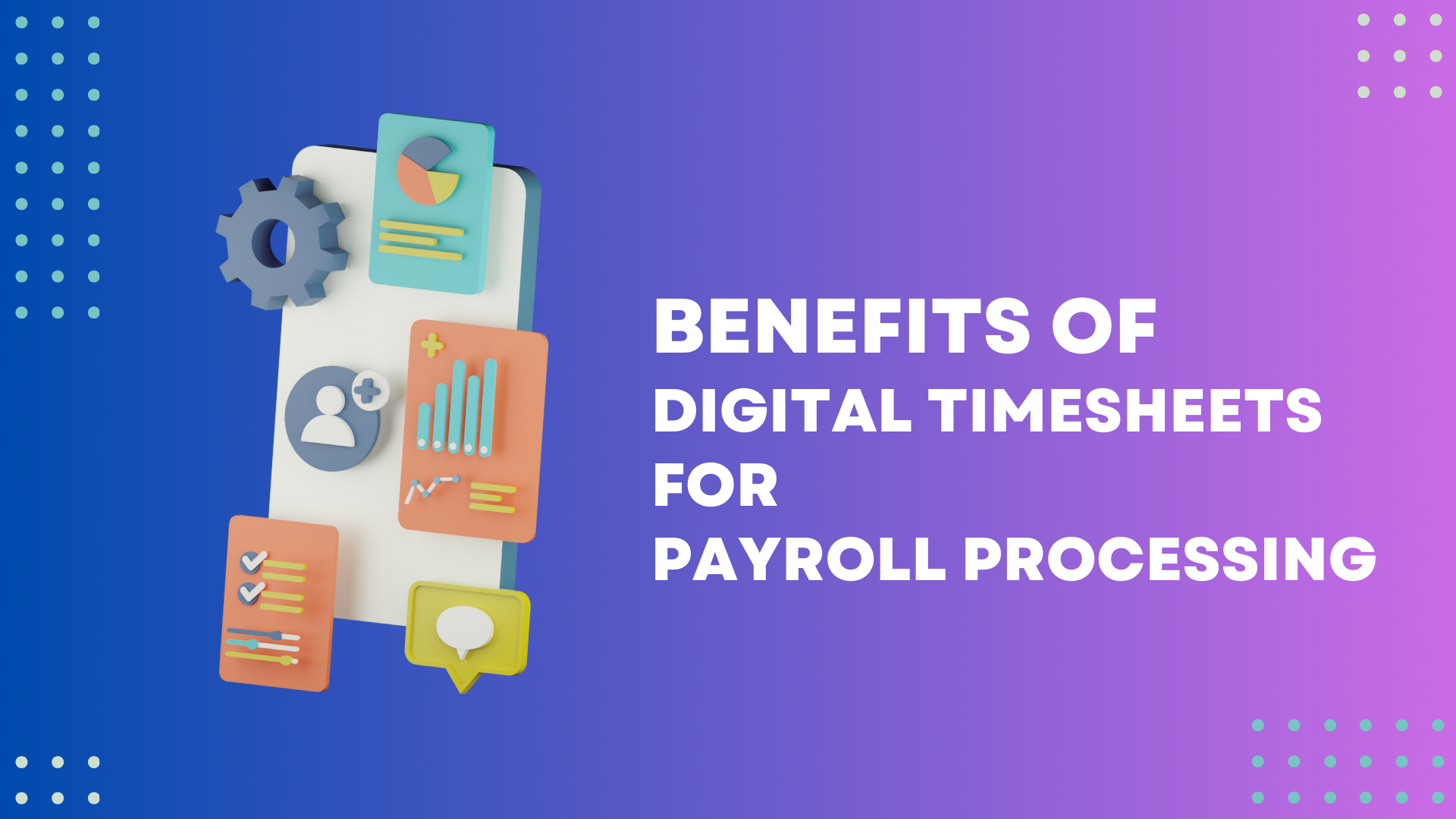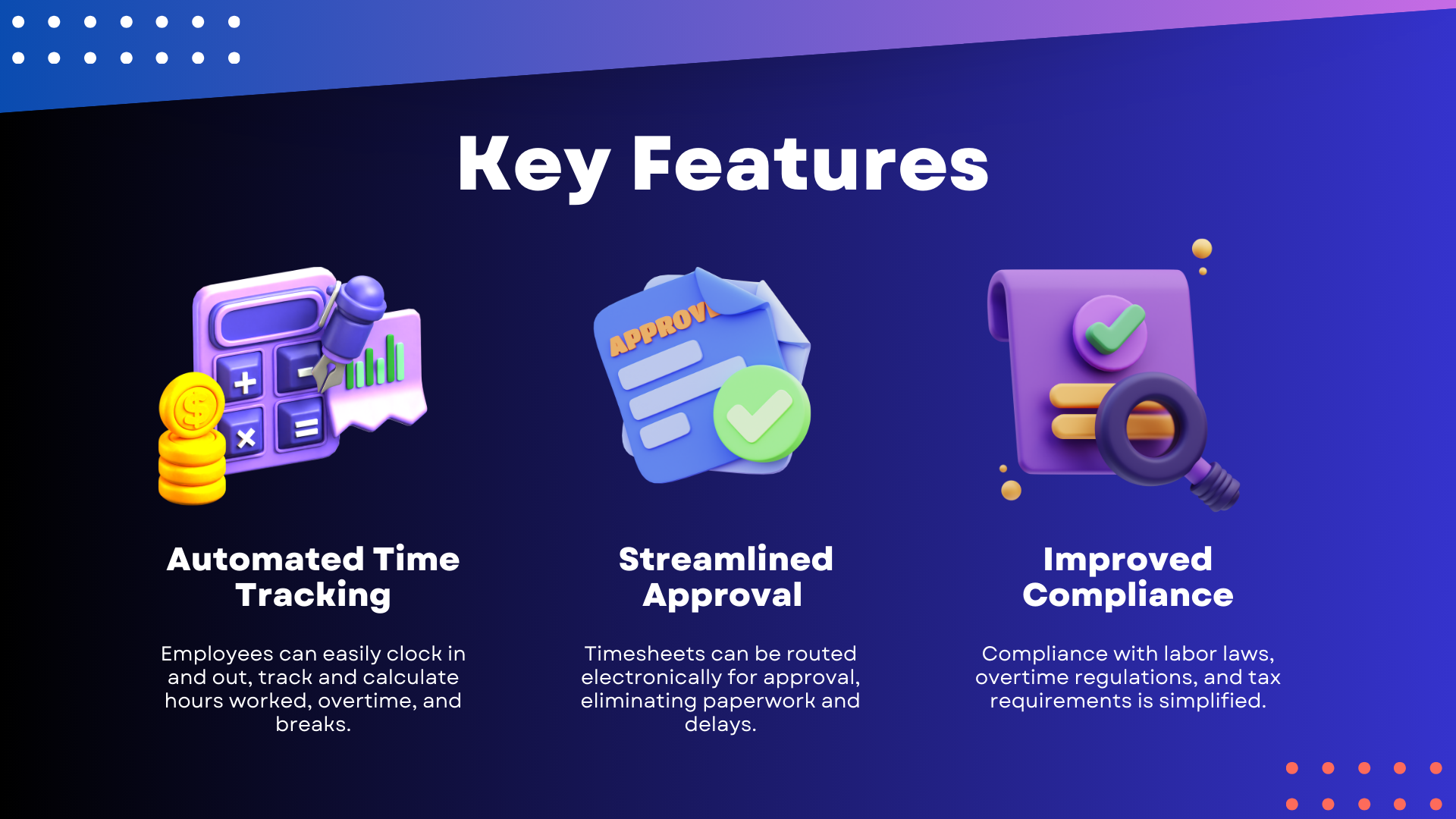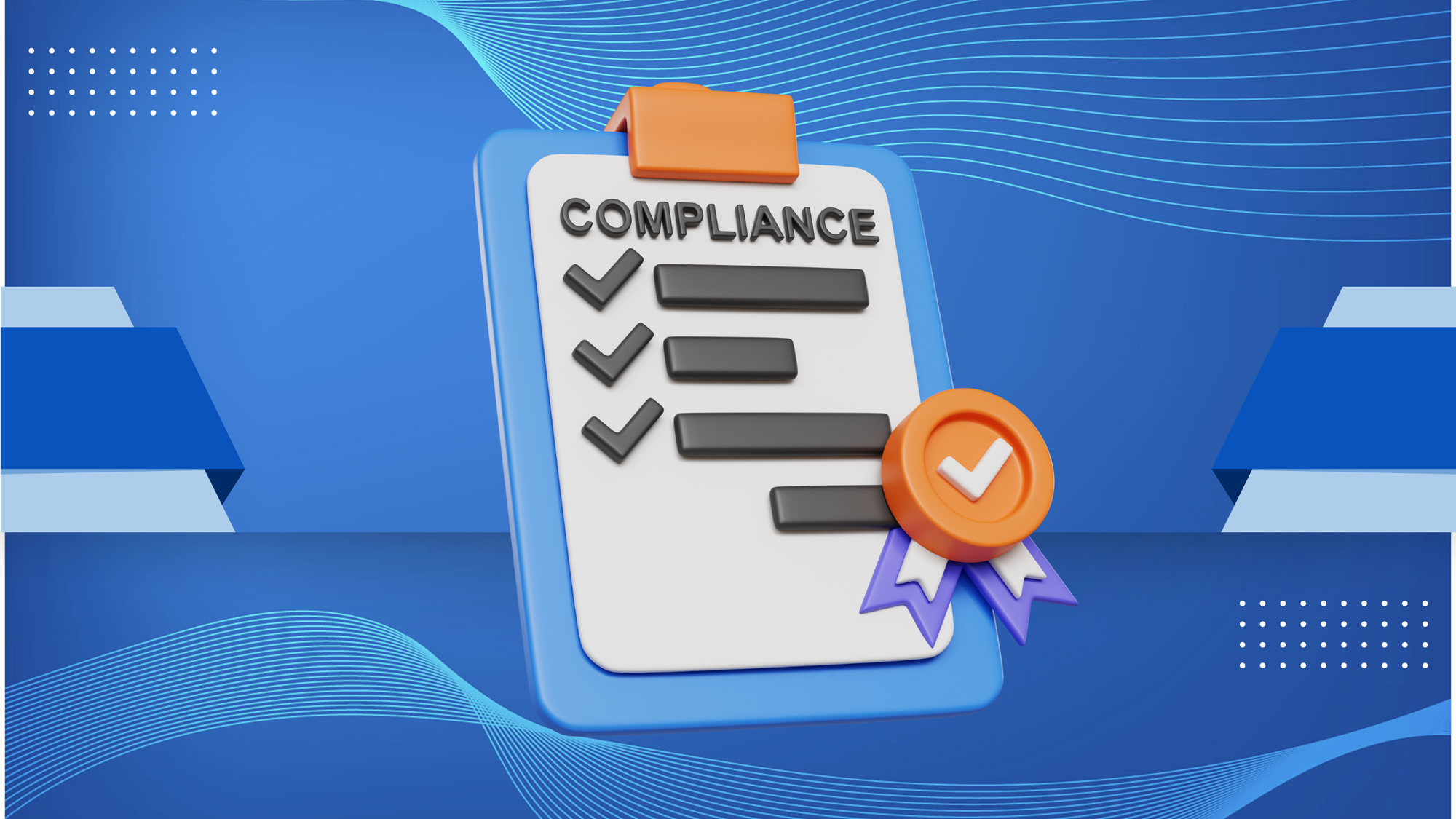How to Streamline Payroll Processing with Digital Timesheets
Learn how to streamline your payroll processing by implementing digital timesheets. Discover the benefits of digital timesheets for your business and improve efficiency in managing your employee’s time and attendance.

Businesses spend 5 days per month on payroll processing. It's a significant drain on resources and productivity as it equates to approximately 25% of total working hours dedicated solely to payroll, highlighting the critical need for optimization.
The rise of remote work, with 16% companies operating fully remote, has only amplified the need for efficient payroll software for small business.
This shift in work dynamics presents unique challenges for traditional payroll systems, such as tracking remote work hours accurately and ensuring compliance with varying labor laws across different locations.
Digital timesheets have emerged as a promising solution to address these challenges. Research indicates that employee timesheet apps can substantially streamline payroll by reducing errors, enhancing accuracy, and automating calculations.
This, in turn, frees up valuable time for HR and finance teams to focus on strategic initiatives.
How can businesses leverage digital timesheet technology to navigate changing work dynamics and optimize payroll operations?
By adopting digital timesheets, businesses can experience a multitude of advantages, including increased efficiency, improved accuracy, cost savings, enhanced employee satisfaction, and better data-driven decision-making.
Why Digital Timesheets?
Inefficient payroll is more expensive than you think. It causes:
- Employee dissatisfaction (payroll errors hurt morale and productivity)
- Poor business decisions (lack of clear pay data hinders planning)
- Overworked staff (payroll issues add pressure to busy teams)
- Compliance risks (new labor laws increase the stakes for accurate records).
If you use traditional paper-based timesheets, they may present several challenges:
- Inaccuracy (manual entries are prone to errors and inconsistencies)
- Inefficiency (the process of filling out, submitting, and processing paper timesheets is time-consuming)
- Cost (paper timesheets require physical storage and management, increasing administrative costs and wasting resources)
- Limited Accessibility (paper records can be difficult to access remotely, limiting the flexibility and responsiveness of the system)
- Security Risks (physical timesheets are susceptible to loss, damage, and unauthorized access, compromising the security of sensitive information).
The Bottom Line: Traditional, paper-based timesheets are prone to errors, time-consuming, and lack the flexibility required in today's dynamic work environments. Digital timesheets offer a modern, efficient, and accurate alternative.
Let's explore the transformative potential of this technology in modernizing workforce management and payroll processing.
What Are Digital Timesheets?

Digital timesheets are electronic systems that allow employees to calculate and record:
- working hours
- breaks
- leave
- payroll.
These systems use software applications that can be accessed via computers, tablets, or smartphones.
How It Works: Employees input their working hours directly into the digital system, which automatically records, stores, and processes this data.
Managers can then review, approve, and analyze the timesheet data in real time, making the process more efficient and accurate.
Benefits for Payroll Processing

Switching to digital timesheets offers numerous advantages.
Automation of the Work Processes
Digital timesheets, powered by automation, eliminate the manual entry of hours, reducing the potential for errors and saving valuable time for both employees and HR departments. This automation also enables real-time data analysis, providing actionable insights into workforce utilization and project performance.
High Payroll Accuracy and Speed
Automated systems reduce the risk of human error, ensuring more precise tracking of hours worked and leave taken.
Increased Efficiency
Digital timesheets streamline the time-tracking process, making it quicker and easier for employees to log hours and for managers to process them.
Significant Cost-Saving
Reducing the reliance on paper lowers administrative costs and minimizes waste, resulting in significant cost savings over time.
Improved Employee Satisfaction
With an intuitive and accessible system, employees experience less frustration and greater convenience, leading to higher overall satisfaction.
Additionally, digital timesheets can help improve employee engagement by providing transparent visibility into their work hours and earnings.
Types of Digital Timesheets
With the numerous options available, selecting the right digital timesheet solution can be overwhelming.
However, understanding the different types of digital timesheets can help businesses and individuals choose the best fit for their needs.
Standalone: Independent application focused solely on time tracking.
✅Simple, manual entry of hours & breaks
❌Limited features
Spreadsheet-Based: Uses a spreadsheet program (like Excel) for time entry and calculations.
✅Customizable, familiar interface, formulas for calculations
❌Manual entry, limited integration
Cloud-Based: Accessed through a web browser, data stored online.
✅Accessible, automatic backups, integrations
❌Subscription costs, internet required
Mobile Apps: Time tracking via a smartphone or tablet app.
✅Convenient, real-time tracking, GPS
❌Battery drain, mobile device dependent
Integrated Systems: Part of a larger HR or project management software.
✅Comprehensive functionality, seamless with existing software
❌Complex, expensive
Project Management Tools: Time tracking as a feature within project management software.
✅Unified platform for project & time management
❌Less time-specific features
Biometric Integration: Uses biometric data (fingerprint, facial recognition) for time tracking.
✅High accuracy, reduces time fraud
❌Higher costs, privacy concerns
AI-Powered: Uses artificial intelligence for automated time tracking and analysis.
✅Automation, detailed analytics
❌Setup, training, subscription costs
When choosing a digital timesheet solution, consider the following factors:
- the size of your business
- the complexity of your payroll
- the level of integration required with other systems
- the budget.
Digital Timesheets Key Features

Time Tracking: Employees can easily log their working hours, including start and end times, breaks, and leave.
🔍Ensures accurate and real-time recording of work hours, reducing manual errors.
Overtime Calculation: Automatically calculates overtime based on predefined rules and policies.
🔍Simplifies payroll processing and ensures compliance with labor laws.

Shift Scheduling: Allows managers to create and manage employee shift schedules within the system.
🔍Enhances workforce management, reduces scheduling conflicts, and improves operational efficiency.
Approval Workflows: Provides a streamlined approval process for timesheets, where managers can review and approve entries.
🔍 Ensures accountability and accuracy in time reporting, while reducing administrative overhead.
Integrations: Integrates with other business systems such as payroll, HR management, project management, and accounting software.
🔍Creates a seamless flow of information across different business functions, enhancing overall productivity and data accuracy.
💡Digital timesheet systems can additionally offer time-off management, attendance tracking, and employee self-service portals.
Improve Payroll Management with Digital Timesheets in 10 Steps

Step 1: Automate Time Tracking
Replace manual time tracking methods with digital timesheets that can automatically capture employee work hours, breaks, and time off.
Step 2: Choose a User-Friendly Platform
Select a digital timesheet platform that is easy to use, accessible on various devices, and integrates with your existing payroll system. Ensure it has a simple and intuitive interface for employees to clock in and out.
Step 3: Set Up Customizable Approval Workflows
Configure approval workflows that fit business needs. This ensures that managers and supervisors can review and approve employee hours, reducing delays in payroll processing.
Step 4: Implement Real-Time Notifications
Set up real-time notifications to alert managers and employees of pending approvals, missed punches, or errors to prevent delays and ensure accurate payroll processing.
Step 5: Integrate with Payroll Software
Integrate your digital timesheet platform with payroll software to streamline data transfer and reduce errors. This helps exchange data without friction and timely process the payroll.
Step 6: Enable Mobile Access
Provide employees with mobile access to digital timesheets, allowing them to clock in and out, request time off, and view their schedules on the go. This increases flexibility and reduces errors.
Step 7: Track Time Off and Leave
Use digital timesheets to track employee time off, vacation days, and sick leave. This helps managers and HR teams ensure flawless payroll processing and compliance with company policies.
Step 8: Analyze Time and Attendance Data
Use digital timesheets to analyze time and attendance data, identifying trends, and areas for improvement. This helps optimize staffing, reduce labor costs, and improve productivity.
Step 9: Ensure Compliance and Security
Ensure your digital timesheet platform complies with relevant labor laws and regulations, such as the Fair Labor Standards Act (FLSA). Also, ensure the platform is secure, with features like data encryption and access controls.

Step 10: Monitor and Evaluate
Regularly monitor and evaluate the effectiveness of your digital timesheet platform. Gather feedback from employees and managers, and make adjustments to ensure the platform meets the evolving organizational needs.
Use TMetric Digital Automated Timesheets for Streamlined Payroll Processing
TMetric digital timecards provide a comprehensive solution to many of the challenges associated with payroll processing.

How TMetric digital timesheets work in payroll processing
- Employee time tracking: Employees track their work hours using TMetric time-tracking feature, which can be accessed via web, mobile, or desktop apps.
- Timesheet approval: Managers review and approve employee timesheets, ensuring accuracy and completeness.
- Data export: Approved timesheet data is exported to the payroll processing system, either manually or through automated integration.
- Payroll processing: The payroll processing system calculates employee salaries based on the exported timesheet data.
- Payroll reporting: TMetric provides detailed reports on employee work hours, salaries, and other relevant payroll data, helping with auditing and compliance.
Integration with other systems
TMetric can be merged with other systems including payroll and integrated platforms:
Benefits of using TMetric digital timesheets in payroll processing
Accurate time tracking
TMetric automated time-tracking feature ensures that employee work hours are accurately recorded, reducing errors and discrepancies.
Easy data export
TMetric allows for easy export of timesheet data to payroll processing systems, eliminating manual data entry and reducing administrative tasks.
Reduced administrative costs
By automating time-tracking and payroll processing, TMetric helps reduce administrative costs associated with manual data entry and processing.
Streamlined payroll processing
With TMetric, payroll processing becomes faster and more efficient, as all relevant data is readily available and easily accessible. process. The mobile app access allows employees to log their hours from anywhere, increasing convenience and satisfaction.
Compliance
TMetric helps ensure compliance with labor laws and regulations by providing a clear and transparent record of employee work hours and salaries. Furthermore, employees have access to their own time records, which promotes transparency and trust in the payroll.
TMetric offers a variety of pricing plans to suit different business needs, making it accessible to companies of all sizes.
Best practices for implementing TMetric digital timesheets in payroll processing
- Configure TMetric to meet your payroll processing needs: Set up TMetric to track the specific data required by your payroll processing system.
- Establish clear timesheet approval processes: Define approval workflows to ensure accurate and timely timesheet approval.
- Regularly review and audit timesheet data: Verify the accuracy of timesheet data to prevent errors and discrepancies.
- Provide training to employees and managers: Ensure that all users understand how to use TMetric and the payroll processing system effectively.
Conclusion
By embracing digital timesheets, businesses can revolutionize their payroll process.
Not only does this technology eliminate the manual burdens associated with traditional timekeeping, but it also empowers employees to take ownership of their hours worked.
This streamlined approach fosters a more accurate, efficient, and compliant payroll system, freeing up valuable resources for strategic initiatives.
Ultimately, adopting digital timesheets is an investment in the future of workforce management, driving operational excellence and financial growth.


